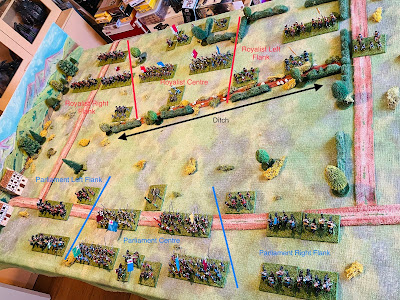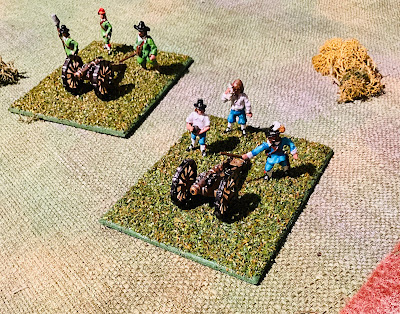In this game report, I am playing a scenario based on the First Battle of Newbury from C.F. Wesencraft's book "With Pike and Musket". Both armies are being directed by the solo decision cards (see here for details on the decision cards).
 |
| The game in progress. |
The order of battle and deployment…
Royalist Army
Right Wing
- 1 detachment of dragoons
- 1 cavalry in the first line (veteran unit)
- 1 cavalry in reserve
Centre
- 2 artillery
- 2 infantry in the first line (1 is a veteran unit)
- 1 infantry in reserve
Left Wing
- 1 cavalry in the first line
- 1 cavalry in reserve
Parliamentarian Army
Right Wing
- 1 cavalry in the first line (veteran unit)
Centre
- 2 artillery
- 2 infantry in first line
- 2 infantry in reserve
Left Wing
- 1 cavalry in the first line (veteran unit)
- 1 cavalry in reserve
 |
| Parliament deployment on the left and Royalist deployment on the right. |
A note on the rules. I am using my D3 ECW rules but have changed the sequence of play and include simultaneous combat for shooting and melee. At the start of a game turn each player rolls a D6. The highest scoring player will move first as Player A, re-rolling any ties.
- Movement for player A.
- Movement for player B.
- Both player’s units shooting simultaneously.
- Both players' units melee simultaneously.
- Remove eliminated units and check for impetuous cavalry.
I will be updating the rules and posting over the next week, once I type up my notes.
On to the game…
The initial turns of the battle saw Parliament seizing the initiative, advancing their dragoons and exchanging artillery fire with the Royalists. As the opening moves developed, both armies committed their cavalry, while the Royalist centre infantry pushed forward. However, the presence of hedges delayed the advance of the Royalist right flank. However, it was not long before the cavalry on both flanks were engaged in combat, charging and counter-charging.
 |
| Opening artillery salvos. |
 |
Cavalry advance on both flanks.
|
 |
| As the cavalry engage on each flank the Royalist centre advances. |
As the Royalist centre pressed forward, the Parliamentarian commander responded, advancing his own centre in a bid to counter the enemy's progress. Both commanders deployed their reserves to reinforce their flank cavalry and provide crucial support. While In the centre, infantry units from both armies began exchanging musket fire. A breakthrough occurred on the Royalist right flank with their cavalry breaking through the Parliamentarian cavalry, sending them into a panicked retreat. The impetuous Royalist cavalry pursued the routed enemy, driving them off the field and also taking themselves out of the battle.
 |
The centres advance and engage in musket fire.
|
 |
| The game is at a critical point with no losses by either side yet. |
 |
| The Royalist right flank finally breaks Parliament’s left flank and pursues them off the tabletop. |
The Royalist dragoons seize the opportunity to position themselves on the exposed left flank of the Parliamentarians. With a clear line of sight, they readied their carbines to unleash a volley of fire. Seeing the imminent threat, Parliamentarian forces reacted and position their reserve infantry to block the danger.
Meanwhile, in the centre of the battlefield, the Royalist infantry first line were sustaining damage from the Parliamentarian musketry. Despite the mounting losses, the Royalists are yet to deploy their centre reserve.
On the other flank cavalry reserves from both forces continue the cavalry engagement.
 |
| The action is on both flanks with dragoons flanking the centre and the cavalry battle continues on teh near flank. |
 |
| Parliament’s centre is starting to put pressure on the Royalist infantry. |
The Royalist first line of infantry in the centre had resisted the larger Parliamentarian infantry force. However, the weight of numbers eventually took its toll, and the Royalists were routed. A late charge by the Royalist right flank cavalry reserve sought to turn the tide of the battle, but the hedges limited their effectiveness and they could not halt the advance of the Parliamentarian infantry centre.
On the opposite flank, the cavalry forces of both sides had engaged in fierce combat. Exhausted and depleted, both cavalry forces found themselves at a stalemate, unable to continue.
The Royalist commander observed the advance of the Parliamentarian infantry, choosing not to commit the final reserve of infantry and retired from the battlefield.
 |
A final Royalist cavalry attack by their reserve through the hedges.
|
 |
| The Royalists retire. |
Summary
The battle proved to be a closely contested affair, with victory hanging in the balance until the final turns. Had the Royalist cavalry performed better, the outcome may have been different and favoured them. However, similar to the actual historical battle upon which the scenarios is based, the presence of hedges posed significant challenges for the Royalist cavalry on their right flank. Allowing the Parliamentarian forces to leverage their numerical advantage in the centre, and eventually gaining control of the battlefield.
 |
| A commander’s view midway through the battle. |
I am planning to post the solo decision cards, current version, and also the updated D3 ECW rules which have been modified over the past month or so to accommodate the decision card approach.
























































